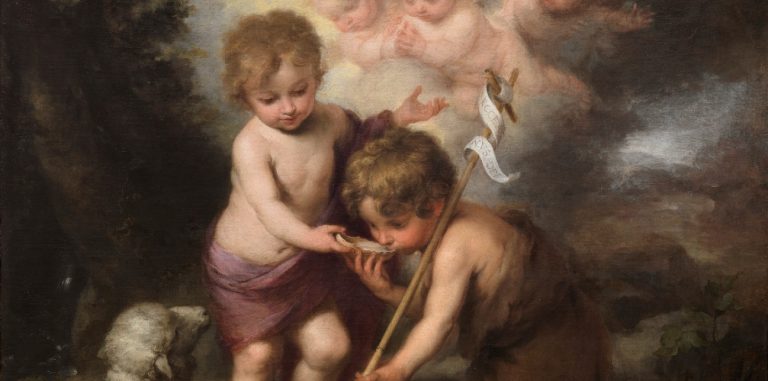By Edward Sri
Dr. Edward Sri is professor of theology and Scripture and Vice President of Mission at the Augustine Institute, Vice President of Formation of FOCUS, and a St. Paul Center Fellow. He is the author of numerous books on Catholic theology and Scripture study, including God with Us: Encountering Jesus in the Gospel of Matthew.

The first time I visited the Jordan River—the place where John the Baptist began his ministry—I couldn’t help but think that this prophet could have chosen a much better place to launch his career of preparing the Jewish people for the Messiah.
The Jordan River flows through a barren wilderness into the lowest point on the entire face of the earth, some 1,200 feet below sea level. To get there, the crowds would have to trek several hours down through the rugged desert terrain with the hot, piercing sun relentlessly beating down on their backs. Who would want to go all the way down there to hear John the Baptist? It seems that the capital city of Jerusalem would have been a much better site for attracting listeners. Or maybe the densely populated region of Galilee. But the empty wilderness and the Jordan River basin?
Yet, for the ancient Jews, the Jordan River valley was much more than a desolate wilderness. It was the very place where they expected God to do great things for Israel again. And this makes all the difference for understanding the mission of John the Baptist and his fateful encounter with Jesus at that river.
The Jews knew that great things happened at the Jordan River. This is the place where the prophet Elisha cured Naaman, servant of the King of Syria (2 Kings 5:1-14). This is where the prophet Elijah was taken up into heaven in a fiery chariot (2 Kings 2:1-10). But most of all, this river would bring to mind the most important event in Israel’s history—the Exodus. To this day, Jews annually recall the story of the Exodus, retelling how God freed the Israelites from slavery in Egypt, led them through the Red Sea, and guided them in the desert for forty years. The climax of this drama comes when Joshua led the Israelites through the Jordan River and into the land God had promised them. It was then that Israel began its life anew as a nation in the land of Canaan.
As such, the Jordan River valley became a rich symbol for new beginnings and new life. It expressed Israel’s hopes for the future, hopes for a new type of exodus, when God would once again free His people from their pagan enemies as He did back in the time of Moses and Joshua.
This is why John the Baptist called the people out into the wilderness to be baptized in the Jordan. Such an action would signal the beginning of all that the Jews had been hoping for. This was a symbolic action, ritually reenacting the Exodus. Just like their ancestors, the Jews following John the Baptist went out into the wilderness, passed through the Jordan, and reentered the Promised Land. And they came out on the other side with all their hopes for a fresh start—hopes for freedom, this time not from the Egyptians but from their current oppressors, the Romans. One can imagine the great enthusiasm and anticipation surrounding John the Baptist’s movement. It’s no wonder John had little trouble attracting so many people!
Saint Matthew’s Gospel does not tell us much about what John the Baptist taught at the Jordan. In fact, he only quotes nine words from John’s actual preaching: “Repent, for the kingdom of heaven is at hand” (Matt 3:2). It might seem odd that Matthew uses more words describing the type of clothes John the Baptist was wearing than he does telling us about the content of John’s message. However, anyone familiar with the Old Testament would find great significance in John’s being garbed in camel’s hair and a leather girdle around his waist—for this is exactly what the great prophet Elijah was known for wearing (2 Kings 1:8).
This was significant because the Jews had been waiting for Elijah’s return. To understand this, consider the very last prophetic words addressed to Israel in the Old Testament. Malachi was the last prophet sent to Israel and, in his final prophetic utterance, he said Elijah would in some way return to Israel before the time of the Messiah (Mal 4:5). For centuries after Malachi, the Jewish people waited in silence with no prophet being sent to them (1 Mac 9:27; 14:41). These last words about Elijah’s reappearance were left echoing in their ears, as they anticipated the coming of Elijah and the Messiah who would follow after him.
Thus, when John began his ministry dressed with Elijah-styled camel’s hair and leather girdle, this signaled to the Jews that he was playing the part of the returned Elijah. Indeed, Jesus Himself later recognized this, saying “For all the prophets and the law prophesied until John; and if you are willing to accept it, he is Elijah who is to come” (Matt 11:13-14). Acting as the new Elijah, John the Baptist announced that Malachi’s prophecy was coming to fulfillment and that the time of the Messiah was just around the corner!
When John baptized Jesus, Jesus received the Spirit descending upon Him like a dove, and this event served as the foundation for His public ministry. Jesus then went on to do even greater works than John the Baptist. Like Elisha, Jesus also cleansed lepers (Matt 8:2-4), raised a child from the dead (Matt 9:23-25), and multiplied barley loaves to feed the multitudes (John 6:9-14; Matt 14:15-21; 15:32-38).
What is most significant is the place where Elijah passed on his prophetic mission to Elisha: the Jordan River (2 Kings 2:6-14). At the Jordan, Elijah transferred his ministry to his successor, Elisha. It was also there that the new Elijah—John the Baptist—passed the baton to Jesus, who then began His public ministry as the new Elisha.
You Might Also Like

God with Us: Encountering Jesus in the Gospel of Matthew shows that Jesus didn’t just come to be our teacher, a miracle work or prophet, or even just Israel’s savior and redeemer. Jesus is Emmanuel, God with us. Much has been said about why Jesus died. This book focuses on why Jesus lived.